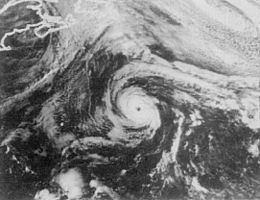Formed November 2, 1994 Fatalities None reported Areas affected Central Atlantic | Dissipated November 8, 1994 Damage None Highest winds 177 km/h | |
 | ||
Lowest pressure 972 mbar (hPa); 28.7 inHg Date 2 November 1994 – 8 November 1994 Similar Tropical Storm Beryl, Tropical Storm Debby, Meteorological history of Hurricane, Hurricane Gordon, Tropical Storm Alberto | ||
Hurricane Florence was a strong, late season hurricane that remained out over the open waters of the Central Atlantic for nearly a week, before being absorbed into a large extratropical cyclone. With peak winds of 110 mph (175 km/h) and a minimum pressure of 972 mbar (hPa; 28.71 inHg), Florence was the strongest storm of the 1994 Atlantic hurricane season. Florence developed out of an area of low pressure associated with a stalled frontal system located 1,150 mi (1,850 km) east-southeast of Bermuda in late October. The system gradually became better organized and was classified a subtropical depression on November 2. The storm intensified into a subtropical storm shortly thereafter before weakening to a depression the next day.
Contents
After gaining tropical characteristics throughout most of the day on November 3, the storm was designated Tropical Depression Eleven. The depression quickly strengthened into Tropical Storm Florence, the sixth named storm of the season. The storm briefly underwent rapid intensification, strengthening into a hurricane, before leveling out as a Category 1 hurricane. Florence was subsequently upgraded to a Category 2 hurricane on November 7. However, a large extratropical cyclone located to the north caused the hurricane to rapidly accelerate, with forward speeds reaching 58 mph (93 km/h). By the next day, Florence lost its identity, while still producing hurricane-force winds, as it was absorbed by the extratropical cyclone.
Meteorological history
The origins of Florence can be traced back to an area of low pressure which developed in late October along a stationary front located 1,150 mi (1,850 km) east-southeast of Bermuda. The low gradually detached from the front and began developing convective banding features. The system was not fully tropical as the strongest winds were recorded a couple hundred miles from the center, leading to the system being classified a subtropical cyclone on the morning of November 2. Minor intensification followed shortly after and the subtropical depression was upgraded to a subtropical storm. This was based on ship reports of 40 mph (65 km/h) sustained winds associated with the system. By November 3, the storm became slightly disorganized and was downgraded to a subtropical depression. By the afternoon, the subtropical system began to undergo a transition from a subtropical system to tropical system. Later that day, the storm was classified Tropical Depression Eleven while located 875 mi (1,400 km) east-southeast of Bermuda. The depression was moving towards the northwest at 8 mph (13 km/h) and the same general motion was expected as a large upper-level low situated over the system was forecast to move towards the northeast, leading to Eleven moving around the periphery of the low.
The depression was upgraded to Tropical Storm Florence the next morning. However, outflow from the storm remained poor as the upper-level low was still interacting with the center of Florence and the storm was still not completely tropical but there was slight improvement. By the afternoon of November 4, Florence completed its transition into a tropical cyclone and deep convection developed, causing the storm to quickly intensity; with winds increasing by 20 mph (30 km/h) in a 6 hour time period. The trend in intensification was forecast to continue and Florence was forecast to become the second hurricane of the season within 12 hours. Late on November 4, Florence was upgraded to a hurricane as a solid area of deep convection developed around the center of circulation. An eye feature also appeared on infrared satellite but was not associated with significant strengthening. Florence slowly intensified as the eye persisted and the structure slightly improved. By the morning of November 6, the eye became less defined and the cloud tops around it warmed. The storm also shifted its foreword motion northward as the trough located to the southeast began to move towards the east, moving the steering currents with it. As the low moved further to the east, steering currents in the area of Florence weakened, leading to the storm stalling late on November 6.
By the morning of November 7, the eye began to reappear and the storm turned towards the northwest and the foreword motion began to rapidly increase. Later that morning, Florence had developed a large, 35 to 40 mi (55 to 65 km/h) wide eye and the foreword motion continued to increase. The intensification continued and by the afternoon hours, Florence was upgraded to a Category 2 hurricane with winds of 100 mph (155 km/h). A strong extratropical cyclone located to the north of Florence was causing the storm to move towards the northwest at a rapid pace of 30 mph (48 km/h). Operationally, Florence was reported to have peaked at that intensity, but post season analysis determined that the storm reached its peak intensity just short of major hurricane—a storm with winds of 111 mph (178 km/h) or higher—status late on November 7. By the morning of November 8, Florence weakened slightly to Category 1 status. The large system to the north continued to cause Florence to move at 58 mph (93 km/h). Since the storm was very close to a cold front, Florence was expected to rapidly transition into an extratropical cyclone. Later that morning, Florence was absorbed into the extratropical cyclone while still maintaining hurricane-force winds.
Impact and naming
As Florence remained out over the open waters of the central Atlantic, no effects, damages, or fatalities were reported. No tropical storm watches or warnings were issued, and the storm was never forecast to strike land.
